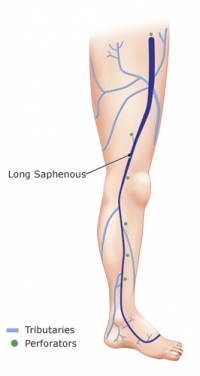How Do Perforators Contribute to Varicose Veins?
 In
addition to saphenofemoral
reflux and valve incompetence causing symptomatic
venous reflux disease, there are several sites along the
greater saphenous vein where there is potential for
brach varicosities. These include the performator veins
which allow communication between the superficial and
deep venous system of the legs.
In
addition to saphenofemoral
reflux and valve incompetence causing symptomatic
venous reflux disease, there are several sites along the
greater saphenous vein where there is potential for
brach varicosities. These include the performator veins
which allow communication between the superficial and
deep venous system of the legs.
The superficial veins communicate with the deep veins via perforator veins. There are valves within these perforator veins which can also become incompetent and cause branch vein varicosities along the knee and calf.
In the past, surgery designed to divide the perforating veins, such as Cockett and Linton procedures, were associated with considerable morbidity. The recently developed technique of subfascial endoscopic perforator surgery (SEPS) has allowed perforating veins to be divided effectively but with considerable incisions and down time.
There is hope! New technology using radiofrequency ablation allows for obliteration of these perforators under local anesthesia in an ambulatory office setting. New VNUS catheters allow for obliteration of these perforators in the mid calf or thigh.
Patients can now return to work within 24 hours of VNUS Closure for perforator veins.
Patients with venous ulcers in the legs may well have perforator reflux and can be screened by an ultrasound and duplex study.